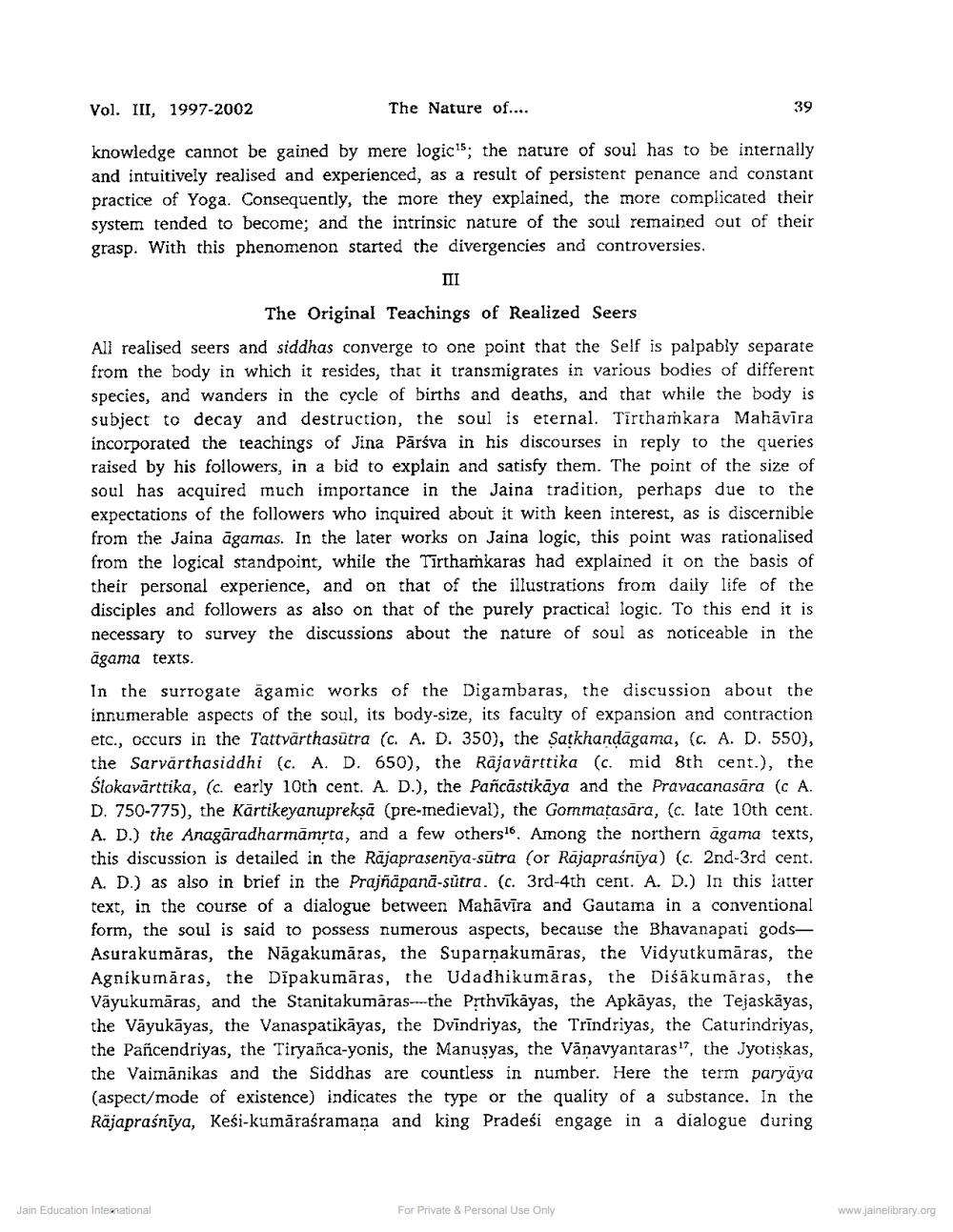Book Title: Nature of Soul in Jainism Parapsychological View Point Author(s): N M Kansara Publisher: Z_Nirgrantha_1_022701.pdf and Nirgrantha_2_022702.pdf and Nirgrantha_3_022703.pdf View full book textPage 3
________________ Vol. III, 1997-2002 The Nature of.... 39 knowledge cannot be gained by mere logic"5; the nature of soul has to be internally and intuitively realised and experienced, as a result of persistent penance and constant practice of Yoga. Consequently, the more they explained, the more complicated their system tended to become; and the intrinsic nature of the soul remained out of their grasp. With this phenomenon started the divergencies and controversies. The Original Teachings of Realized Seers All realised seers and siddhas converge to one point that the Self is palpably separate from the body in which it resides, that it transmigrates in various bodies of different species, and wanders in the cycle of births and deaths, and that while the body is subject to decay and destruction, the soul is eternal. Tirthamkara Mahāvīra incorporated the teachings of Jina Pārśva in his discourses in reply to the queries raised by his followers, in a bid to explain and satisfy them. The point of the size of soul has acquired much importance in the Jaina tradition, perhaps due to the expectations of the followers who inquired about it with keen interest, as is discernible from the Jaina āgamas. In the later works on Jaina logic, this point was rationalised from the logical standpoint, while the Tirthamkaras had explained it on the basis of their personal experience, and on that of the illustrations from daily life of the disciples and followers as also on that of the purely practical logic. To this end it is necessary to survey the discussions about the nature of soul as noticeable in the āgama texts. In the surrogate ägamic works of the Digambaras, the discussion about the innumerable aspects of the soul, its body-size, its faculty of expansion and contraction etc., occurs in the Tattvārthasūtra (c. A. D. 350), the Satkhandāgama, (c. A. D. 550), the Sarvärthasiddhi (c. A. D. 650), the Rajavarttika (c. mid 8th cent.), the ślokavārttika, (c. early 10th cent. A. D.), the Pancāstikāya and the Pravacanasāra (c A. D. 750-775), the Kārtikeyanuprekşā (pre-medieval), the Gommatasara, (c. late 10th cent. A. D.) the Anagaradharmāmrta, and a few others 16. Among the northern agama texts, this discussion is detailed in the Räjapraseniya-sutra (or Rajapraśniya) (c. 2nd 3rd cent. A. D.) as also in brief in the Prajñāpanā-sūtra. (c. 3rd 4th cent. A. D.) In this latter text, in the course of a dialogue between Mahāvīra and Gautama in a conventional form, the soul is said to possess numerous aspects, because the Bhavanapati godsAsurakumăras, the Nāgakumāras, the Suparnakumāras, the Vidyutkumāras, the Agnikumāras, the Dipakumāras, the Udadhikumāras, the Diśäkumaras, the Vāyukumāras, and the Stanitakumaras--the Prthvīkāyas, the Apkāyas, the Tejaskāyas, the Vāyukāyas, the Vanaspatikāyas, the Dvīndriyas, the Trīndriyas, the Caturindriyas, the Pancendriyas, the Tiryanca-yonis, the Manusyas, the Vānavyantaras', the Jyotiskas, the Vaimānikas and the Siddhas are countless in number. Here the term paryāya (aspect/mode of existence) indicates the type or the quality of a substance. In the Räjapraśniya, Kesi-kumăraśramana and king Pradesi engage in a dialogue during Jain Education International For Private & Personal Use Only www.jainelibrary.orgPage Navigation
1 2 3 4 5 6 7 8 9 10 11
